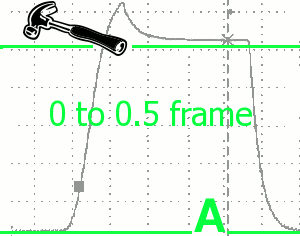20" LCD Monitors: XXL Displays
Spatial Uniformity
The uniformity of the panel was just average, but when displaying a black or white image, we noted no inordinate light leaks.
Up to this point, we could say that the FP202W is an entry-level monitor with nothing to be ashamed of. While its static performance isn't exceptional, users with a little savvy and a little time to spend tweaking will be able to get better results out of it. After all, ease of access is part of what you pay for when you spring for a top-of-the-line unit.
Old-Fashioned Remanence
What a surprise! The BenQ FP202W is an old-style monitor, by which we mean that it doesn't use Overdrive. Unlike the preceding monitors, the latency peaks you see aren't due to poorly controlled Overdrive, just good old TN latency.
It's not as bad as it could be, but as you can see the display is left in the dust in the reactivity department. The peak reached 27 ms.
Overshoot
On the other hand, the display is precise, since Overdrive isn't used. No Overdrive, so no overshoot.
In Use
Get Tom's Hardware's best news and in-depth reviews, straight to your inbox.
The brightness level is too high, which means that you can rule out this monitor if you do a lot of document editing on your computer. For photography, if you have a calibrator, this monitor can do the job. Otherwise, adjusting it manually just seems too complicated to count on getting quality color rendering.
The monitor wasn't very comfortable with video games. It's a long way from the comfort of 4 ms and 2 ms TN panels, and even 8 ms MVA panels from the earlier generation do better. Still, it's acceptable for occasional gaming, and also if you play only real-time strategy games, where resolution is more important than reactivity. So be prepared to make some concessions.
Video Games
Video, however, was catastrophic: the TN panel produced too much sparkling. The worst performer was the NEC model we discussed earlier in this article, but the BenQ monitor was just behind it.
Conclusion
Who should consider buying a BenQ FP202W? Gamers are the only candidates we can think of. And not all gamers either. Because of the excessive latency, you'll need to be a fan of quiet games if you don't want to see all those carefully and expensively calculated polygons disappear into a soft-focus effect as soon as anything moves.


